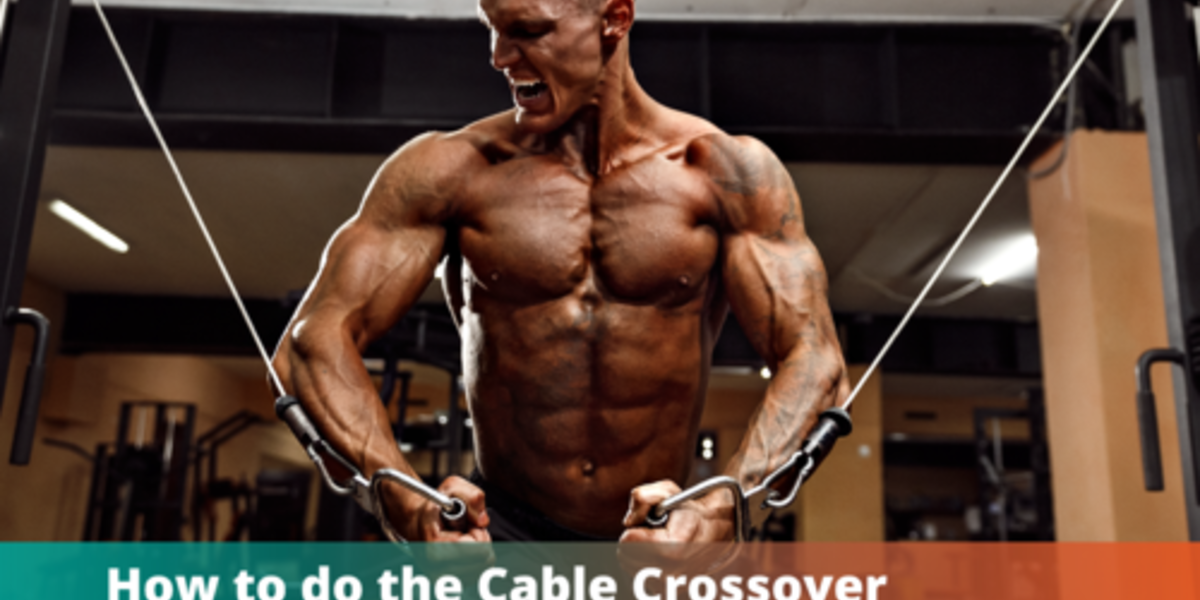Cable Crossover: Every Cable Chest Exercise | Videos & Guide
With the bench press dominating or being the first go-to movement in most recreational gym goer’s routine, exercise movement such as the cable crossover, get neglected or undervalued in workout programmes to bulk up and tone your chest.
Don’t get me wrong, bench pressing or dumbbell pressing is “the” exercise for putting on mass and targeting multiple muscle groups through different planes of motion, however real definition can be achieved through harnessing the various cable cross over exercises which we will show you in this article.
There are a few variances to the cable crossover for chest, depending on what part of the chest you're looking to focus or target.
When you normally think of the cable cross over, we normally associate this with high cable crossover or standing cable cross over as it’s sometimes referred, but there are countless other cable chest exercises that can be utilised:
Standing Cable Crossover
High Cable Cross Over or High Cable Fly
Decline Cable Crossover or Decline Cable Fly
Single Arm Cable Crossover or Single Arm Cable Fly
Cable Crossover with Resistance Bands
Low Cable Crossover / Low to High Cable Crossover
Single Arm Low Cable Crossover or Single Arm Low Cable Fly
In this article we’re going to show you how to:
- Set-up the cable crossover equipment correctly for each exercise
- Position and execute each movement and variation
- Cable cross over muscles worked for each exercise
Let’s jump in…..
If fitness is your passion, go check out our range of fitness courses and Personal Trainer diploma here and start a career you truly care about.
How to Choose the right weight on the cable crossover:
Choosing the right weight depends on your goals:
Tone and Definition – 15 – 20 REPS
Putting on size – 8 – 12 REPS
Never sacrifice weight for technique, especially with these types of movements…..
Standing Cable Crossover / Cable Fly
The standing cable crossover is the most common exercise in cable chest exercise that occurs in the gym. See here how to do perform the movement correctly and read on after on how to adapt the exercise:Set-Up
- When doing the high standing cable crossover place the handles high enough that when the handles drop they are roughly just above shoulder height. This can vary depending on your height.
- Attach stirrup handles to both high pulleys
Starting Position:
- Grab one handle with the inside of your one hand and take a step back to allow you to reach the second cable safely with your other hand.
- Take the tension of the weight
- Keeping your shoulders back and a straight back take a step forward into the resistance with one leg staggered in front of the other (normally dominant leg behind for support) with the front knee bent.
- Pull the weight forward with a slight bend in your elbows with your hands open (more advanced) or closed
Execution:
- Pull your hands down in front of your body in an arc shape until your hands meet around a foot in front of your midriff.
- Squeeze your chest at the end of the movement and slowly realise back to the starting position, before repeating the movement. Keep your elbows higher than your hands throughout the movement.
- Breathe in on the relaxation phase and breathe out when contracting, keeping your head up at all times.
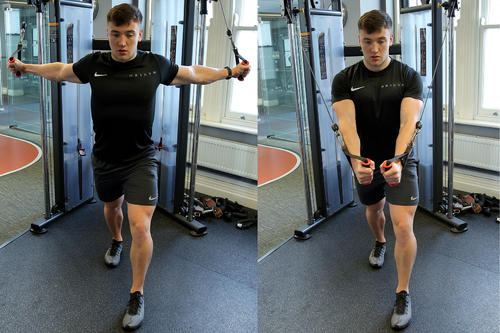
Standing Cable Crossover Muscles Worked:
Prime Mover:
pectoralis major muscles (chest)
Secondary Muscle:
pectoralis minor (chest), rhomboids (back), levator scapulae, anterior deltoids (shoulder) and latissimus dorsi (back)
Common Mistakes with the Standing Cable Crossover:
- Not engaging your core for stability
- Allowing hands to rise above elbows
- Swinging the weights too fast
- Not forming an arc but pushing from the shoulders.
Good to Know
Cable crossovers for chest can be performed with your feet together or without taking a step forward, however when you can lean forward it creates a deeper and more challenging repetition and is more stable.
- Cable crossovers target the pectoralis major muscles' sternal heads, found in the bottom of your chest as well as activating muscles in your shoulder and back.
- The standing Cable crossover exercise recruits the third most muscle fibres in your chest, only behind bench press and flyes.
High Cable Cross Over or High Cable Fly
If you want to use cable crossovers to target slightly higher up the chest, the chest level high cable crossover is a good adaption exercise to the traditional method:
Set-Up and Starting Position: Set-up the high cable cross over in the exact same way as the standing cable cross over and maintain the same starting position.
Execution:
- Pull the weight down and then arc round and allow your hands to meet in the middle a foot or so in front of your lower chest.
- Squeeze the chest at the end of the movement and return to the starting position.
- Keep your head up and core engaged at all times
- Remember to breathe out during contraction and in when returning to the neutral position.
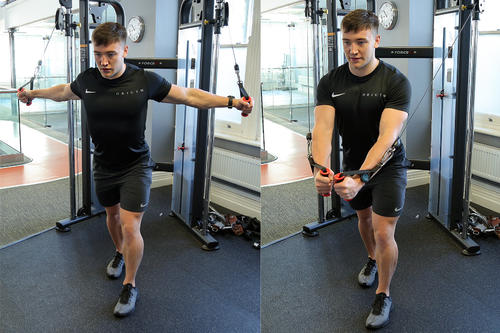
High Cable Crossover Muscles Worked:
Prime Mover:
pectoralis major and minor muscles (chest)
Secondary Muscle:
anterior deltoids (shoulder) and latissimus dorsi (back)
Decline Cable Crossover or Decline Cable Fly
Set Up:
Set up in the same way as performing a standing cable crossover with stirrups on the top left and right-hand side of the cable crossover.
Starting Position:
- Grabbing one stirrup at a time, moving backwards to grab the other, get into the staggered stance as shown earlier taking the tension of the weight.
- Keep palms facing out, head up and core engaged.
Execution:
- With a slight bend in the elbow, keeping your hands below your elbow at all times, pull the weight down and across your body.
- The handles should meet a foot in front on your body, just below your waist. Squeeze and then control your release.
- Remember to breathe throughout the movement.
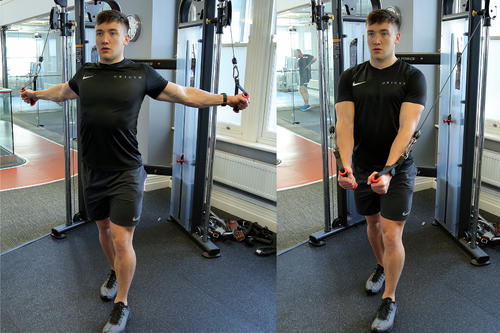
Decline cable crossover muscles worked:
Prime Mover:
pectoralis major (chest)
Secondary Muscle:
Anterior Deltoid (Shoulder)
Common Mistakes to avoid:
- Leaning forward – Keep your body erect and maintain the neutral spine position.
- Lunging forward when contracting. Your body should be almost stationary as you contract. If you find yourself lunging forward, lower the weight.
Single Arm Cable Crossover or Single Arm Cable Fly
Try the single arm cable crossover and as you will see from below, there are a few benefits to the bilateral movement:
Set-Up
Attach a stirrup to one side of the cable crossover machine at a point above your head ensuring the handle is above head height when it is attached.
Starting Position:
- Stand sideways to the stack and grip the stirrup with the inside of your hand.
- Take the tension and take a step back before moving forward into position, keeping feet slightly wider than shoulder width apart.
- Try to avoid leaning to far forward with this unilateral movement as stability may be compromised.
- Place your spare hand against your hip for stability.
Execution:
- Pull your arm down in front of you forming an arc a foot or so in front of your midriff or in front of your chest if you’re performing a unilateral chest level crossover.
- Squeeze your pectoral at the end of the motion and return to the starting position.
- Ensure to keep your core engaged throughout the movement and breathe
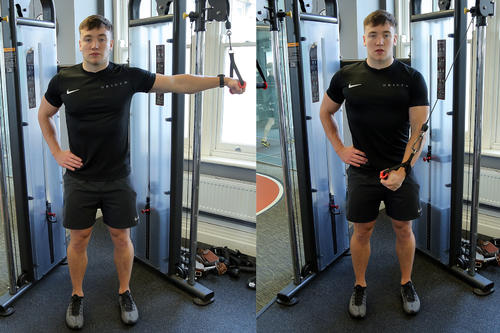
Why do Single Arm Cable Chest Exercises?
- Unilateral cable chest exercise can increase range of motion (ROM) as you’re not inhibited by your other arm
- Allows you to work on muscular imbalances and weaker sides of your body
- Great if you’re training for sport specific purposes e.g. tennis
- Increase kinaesthetic awareness and improve balance
- Increases demand on your core
Common Mistakes to avoid:
- Positioning – Ensure to stand central as if you were doing a bilateral cable crossover.
- Not engaging your core to prevent you from stumbling
- Moving too deep into the movement without a counter weight on the opposite side of the body. Placing your hand on your hip or holding the other pulley in a relaxed state is perfectly acceptable to sustain balance.
Become a Personal Trainer with OriGym!
- Qualify & start earning in just 2 weeks
- Study full-time, part-time or online
- Endorsed by CIMSPA
Cable Crossover with Resistance Bands
Set-Up:
For this cable fly movement, you will need power bands. Using a squat rack, cable crossover machine or any other sturdy piece of apparatus. wrap the resistance band around the sturdy object at roughly chest height.
Starting Position:
- Step out until you feel the tension of the bands.
- Adopt the staggered stance as with the standing cable fly
- Keep arms extended out with a slight bend in the elbow
Execution:
- Pull the weight down and around keeping your core tight and head facing forward.
- The bands should meet in the middle around upper waist height.
- Squeeze, then lower back to the starting position.
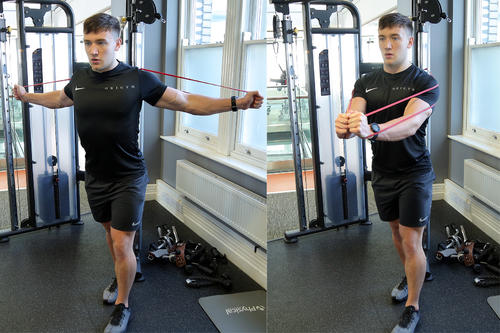
Cable crossover with resistance bands muscles worked:
Prime Mover:
pectoralis major muscles (chest)
Secondary Muscle:
pectoralis minor (chest), rhomboids (back), levator scapulae, anterior deltoids (shoulder) and latissimus dorsi (back)
Common Mistakes to Avoid:
- Foot positioning – Ensure to adopt the staggered stance when using resistance bands as when you release it can pull your back and off balance when feet are positioned together.
- Do not go too far back when releasing back to the starting position as this can place stress on the shoulder joint.
Low Cable Crossover / Low to High Cable Crossover
Low cable crossover or low to high cable crossover as it is sometimes referred is a great muscle definer to add to your list of cable exercises for chest:Set-Up
- Place the stirrups on the lowest point of the cable station on both sides.
Starting Position:
- Grab one handle at a time with the inside of your hand and your palms facing out, feet just wider than shoulder width apart.
- Adopt the staggered stance to increase range of motion
- Keep your shoulders back, core tight and head up throughout the movement.
Execution:
- Pull the weight in a nice smooth arc from your roughly waist height until they’re in line with your upper chest / neck.
- Squeeze your pecs together when executing and release in a controlled manner
- Keep your elbows slightly bent throughout the movement
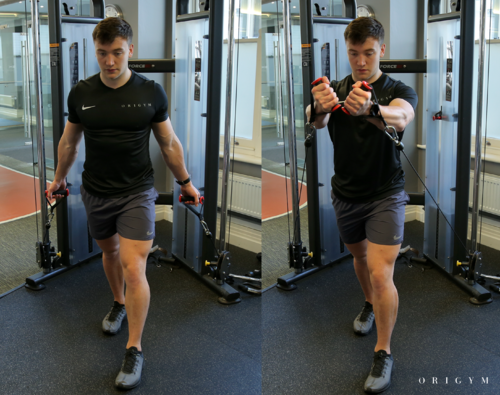
Low Cable Crossover Muscles Worked:
Prime Mover:
pectoralis major (chest)
Secondary Muscle:
pectoralis minor (chest), Latismus dorsi (back), front deltoid (shoulder), bicep brachii (arm)
Common Mistakes to Avoid:
- The most common with the low pulley cable crossover is bending your arms too much that it starts to become a bicep curl.
- Placing too much weight that you do not complete a full range of motion at the top of the movement
Single Arm Low Cable Crossover or Single Arm Low Cable Fly
Like virtually all cable exercises for chest, you can do them bilaterally or unilaterally. Here is how you get set-up to start and execute a single arm low cable fly:
Setup:
Place the stirrup on the bottom of the cable crossover machine on one side.
Starting Position:
- Grab one handle with the inside of your hand with your palm facing out.
- Place your opposite hand on your hip or hold the other stirrup in your other hand for balance
- Ensure you’re standing in the centre of crossover station and feet slightly wider than shoulder width apart
Execution:
- Creating a smooth arc, pull the weight up and round with a slight bend in the elbow.
- Stop at the point of your upper chest / chin and squeeze.
- Keep your head up and facing forward and then slowly release back to the starting position and repeat the movement.
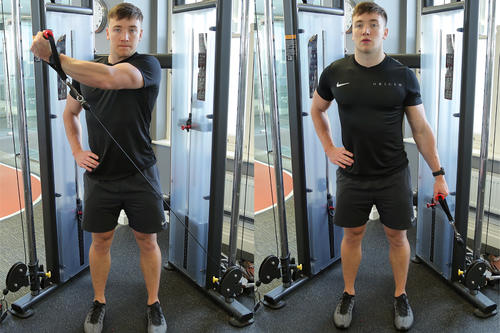
Why not turn your passion for health and fitness into a new and exciting career with OriGym's PT Qualifications or Level 4 Sports nutrition course?
Or, to get a taste of what you could be learning, go ahead and download our latest prospectus here!
